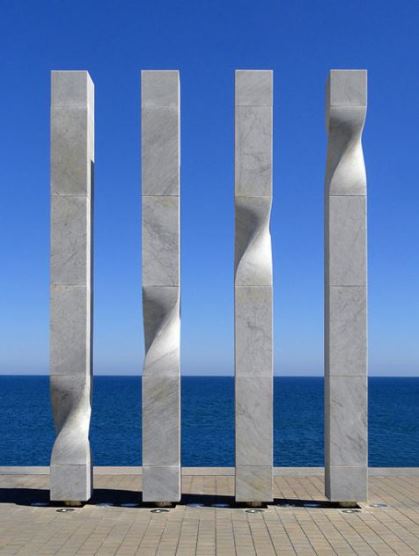Wiki Loves Public Art - winners, successes and challenges
Over the past few months, we’ve been charting the progress of the Wiki Loves Public Art photo competition. Now the contest has finished, we can take a look at the winners and at Europeana's involvement in the process.
The goal of the Wiki Loves Public Art (WLPA) contest was to get as many pictures of public art as possible available under a free licence on Wikimedia Commons. The submissions can now be seen and used by anyone, anywhere. These pictures will help Wikipedia (the world’s sixth largest website) to see a boost in its art coverage as photos in the contest can be added to illustrate articles in the online encyclopedia. The contest was organised by Wikimedia Sverige, Europeana and volunteers in the Wikimedia chapters and affiliated groups in each of the participating countries.
We are pleased to say that it succeeded beyond expectations as there were a total of 9,250 photos submitted by 224 contestants in Austria, Finland, Israel, Spain and Sweden. These photos of over 2,155 different artworks are now available on Wikimedia Commons under free licences, which means they can be re-used in, for example, online projects such as Wikipedia.
The prizes for the three internationally best pictures are travel gift certificates for 500 euros, 300 euros and 200 euros, and on top of that Europeana has sponsored high quality prints of the winning pictures that will be sent to the winners.

First place: Coldcreation‘s image of Ricardo Bofill´s artwork 'Les quatre barres de la senyera catalana', in Barcelona, Spain. Comment from the jury: Simple and bright, well balanced, good composition, lighting, catches the spirit of Barcelona. Credit: ‘Ricardo Bofill (Ricard Bofill Leví), Les quatre barres de la senyera catalana’, by Coldcreation, CC-BY-SA
One of the challenges of this contest was the lack of national databases of public artworks. The countries participating in the contest have a diverse set of copyright laws, which means that the public artworks that could be photographed and uploaded online for the contest differ between countries. For example, in Finland the contest focuses on outdoor sculptures made by artists who have been dead for 70 years or more. In Spain and Austria, on the other hand, any public artwork can be photographed. 'This has also made a difference to the amount of artworks photographed in different local contests. From Barcelona we had over 6,000 pictures, whereas from countries with stricter copyright laws we understandably have fewer contributions', states John Andersson, Wikimedia Sweden.

Second place: Kartanofoto’s images of Emil Wikström’s fountain 'Aino', in Lahti, Finland. Comment from the jury: Vivid and vibrant photo, nice dominance of green color (background, reflections in the water, statues).Credit: ‘Aino-suihkukaivo (1912) – Emil Wikström. Sijainti: Fellmanin kartanon puisto’, by Kartanofoto, CC-BY-SA
Europeana Senior marketing specialist Geer Oskam says, 'The availability of national lists or databases was a problem - even if a local government has collated such a list, it is hard for the Wikimedia Chapters to get hold of them and even more difficult to find a suitable way of distributing them.' To make it easier for people to find the artworks suited for the contest, volunteers in national Wikimedia chapters created lists on Wikipedia.
The other challenge Geer reports is the similarity with the Wiki Loves Monuments photo contest which Europeana also promotes. Because the two contests are similar in format, theme and timing, many Wikimedia communities just don't have the resources or manpower to support both.
In terms of increasing awareness of Europeana through WLPA, we can report some success. The press coverage for WPLA has been good, with many mentions of the contest in the region's taking part. Geer says, 'Europeana's visibility on Wikimedia Commons has grown as a result of the contest. Whilst this may not be easy for the public to see on Wikipedia, it shows Wikimedians themselves how involved we are. Finally, the most interesting thing, for us as co-organisers, is that WLPA has provided a hook for local communities. Together with the local Wikimedia partners, we have been able to motivate people to upload nearly 10,000 images, thus gaining grassroots awareness about Europeana and about the importance of sharing cultural heritage information openly.'

Third place: Gila Brand’s images of Yaacov Agam’s sculpture A Beating Heart, in Jerusalem, Israel. Comment from the jury: Strong, expressive and charming photo, well chosen camera angle and focus, emphasis on the most significant details. Credit: ‘Yaacov Agam’s sculpture A Beating Heart’, Gila Brand, CC-BY-SA
So how has the experience been for Europeana overall? Geer says, 'Europeana and Wikimedia Sweden have happily worked together on the organisation of the Wiki Loves Public Art photo contest. For Europeana, it was a chance to show our devotion to the Wikimedia community, building new relationships with Wikimedians and Wikimedia Chapters all over Europe. By organising WLPA, we have opened a door to Wikimedia chapters in Europe, showing that we are committed to working together with them on their own terms and finding mutual benefits - that's what true collaboration is about.'
Browse the full results of WLPA.
More information on the judging process for the competition
